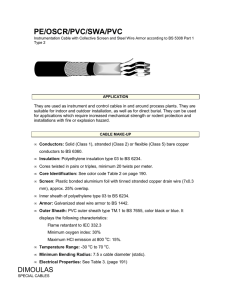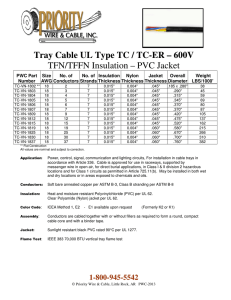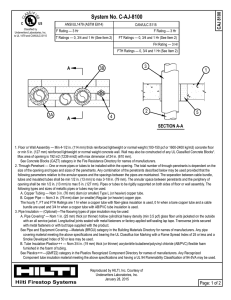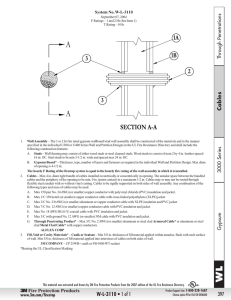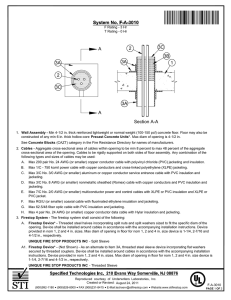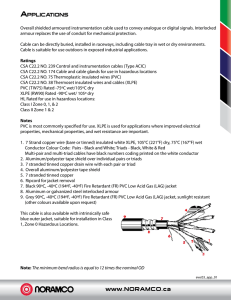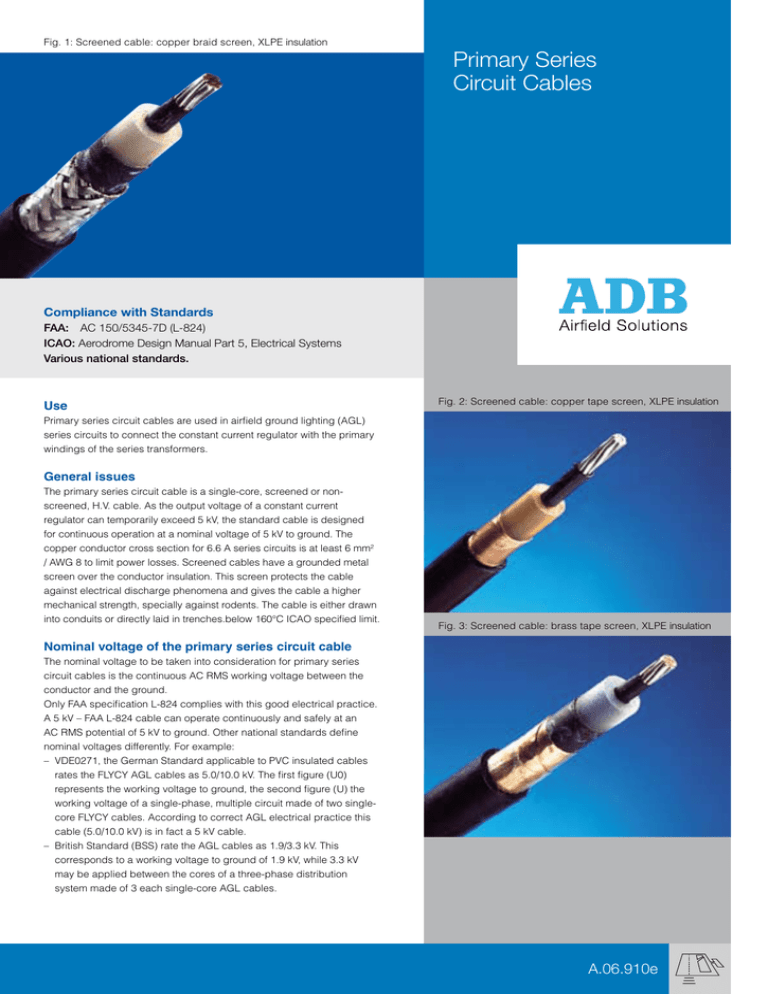
Fig. 1: Screened cable: copper braid screen, XLPE insulation
Primary Series
Circuit Cables
Compliance with Standards
FAA: AC 150/5345-7D (L-824)
ICAO: Aerodrome Design Manual Part 5, Electrical Systems
Various national standards.
Use
Fig. 2: Screened cable: copper tape screen, XLPE insulation
Primary series circuit cables are used in airfield ground lighting (AGL)
series circuits to connect the constant current regulator with the primary
windings of the series transformers.
General issues
The primary series circuit cable is a single-core, screened or nonscreened, H.V. cable. As the output voltage of a constant current
regulator can temporarily exceed 5 kV, the standard cable is designed
for continuous operation at a nominal voltage of 5 kV to ground. The
copper conductor cross section for 6.6 A series circuits is at least 6 mm2
/ AWG 8 to limit power losses. Screened cables have a grounded metal
screen over the conductor insulation. This screen protects the cable
against electrical discharge phenomena and gives the cable a higher
mechanical strength, specially against rodents. The cable is either drawn
into conduits or directly laid in trenches.below 160°C ICAO specified limit.
Fig. 3: Screened cable: brass tape screen, XLPE insulation
Nominal voltage of the primary series circuit cable
The nominal voltage to be taken into consideration for primary series
circuit cables is the continuous AC RMS working voltage between the
conductor and the ground.
Only FAA specification L-824 complies with this good electrical practice.
A 5 kV – FAA L-824 cable can operate continuously and safely at an
AC RMS potential of 5 kV to ground. Other national standards define
nominal voltages differently. For example:
– VDE0271, the German Standard applicable to PVC insulated cables
rates the FLYCY AGL cables as 5.0/10.0 kV. The first figure (U0)
represents the working voltage to ground, the second figure (U) the
working voltage of a single-phase, multiple circuit made of two singlecore FLYCY cables. According to correct AGL electrical practice this
cable (5.0/10.0 kV) is in fact a 5 kV cable.
– British Standard (BSS) rate the AGL cables as 1.9/3.3 kV. This
corresponds to a working voltage to ground of 1.9 kV, while 3.3 kV
may be applied between the cores of a three-phase distribution
system made of 3 each single-core AGL cables.
A.06.910e
Advantages of the use of screened cables
• Electrical
The electrical field in the insulation of non-screened cables with operating
voltages in excess of 2 kV may differ over the length of the cable run. The
potential differences or voltage gradients result in surface discharges,
which may cause surface tracking entailing a faster deterioration of
the cable insulation i.e. reduced lifetime of the cable and higher risk of
electrical shock-hazards to personnel.
The grounded metal screen equalises the voltage gradient in the
insulation over the whole cable length. As a result it eliminates surface
tracking and reduces electrical shock hazards to personnel.
The environment plays an important part in the surface tracking
phenomenon.
Therefore, shielded cables are recommended for circuits with voltages
above 2 kV, when one or more of the following installation conditions
prevail:
– in dry soil (such as in the desert)
– when the cable transits from conductive to non-conductive soil or
conduits
– when the cable transits from dry to wet soil or from dry to moist
conduits
– in moist conduits
– when lubricants have to be used to pull cables into conduits.
Fig. 4: Screened cable, copper wires screen, PVC insulation
• Radio interference
The emission of radio frequency (RF) signals is reduced by the use of
screened cables.
Most constant current regulators generate RF signals, particularly when
operating at reduced load and/or low brilliancy.
The screen strongly attenuates RF emission by the series circuit, which
otherwise would act as a transmission antenna.
• Mechanical
A screened cable has a higher mechanical resistance against termites,
perforating insects and small rodents. Even a damaged outer jacket has
no influence on the electrical field in the cable insulation, which is well
defined between the conductor and the grounded screen.
Fig. 5: Non-screened cable, TPE insulation
The positive effects of the screened cable can only be guaranteed if the
screen is securely grounded and if its electrical continuity is ensured over
the whole length of the series circuit.
Fig. 6: Non-screened cable, XLPE insulation
Technical data
Screened cables
Code
number
PSC-S-…
Copper
conductor
Cross section
Insulation
X-5-6-CB-PE
or
X-5-6-CB-PV
X-5-8-CB-PE
or
X-5-8-CB-PV
X-5-6-CT-PE
or
X-5-6-CT-PV
X-5-8-CT-PE
or
X-5-8-CT-PV
X-5-6-BT-PE
or
X-5-6-BT-PV
X-5-8-BT-PE
or
X-5-8-BT-PV
P-3-6-CW-PV
(*)
(*)
6 mm2
AWG 8
6 mm2
AWG 8
6 mm2
AWG 8
6 mm2
6 mm2
7
7
7
7
7
7
1
1
XLPE
XLPE
XLPE
XLPE
XLPE
XLPE
PVC
PVC
5
5
5
5
5
5
3
5
2.3
2.3
2.3
2.3
2.3
2.3
3
4
Copper braid
Copper braid
Copper tape
Copper tape
Brass tape
Brass tape
Copper wires
Copper wires
0.20
0.20
0.08
0.08
0.08
0.08
0.36
0.36
PE or PVC
PE or PVC
PE or PVC
PE or PVC
PE or PVC
PE or PVC
PVC
PVC
1.2
1.2
1.2
1.2
1.2
1.2
1.8
1.8
11.5
12.0
11.1
11.6
11.1
11.6
13.5
17.5
108
137
81
108
81
108
121
161
183
216
160
190
160
190
280
425
0,8
0,9
0,8
0,9
0,8
0,9
–
–
250
276
208
237
208
237
450
740
0.45
0.66
0.45
0.45
0.45
0.45
1.3
2.85
1
1
2
2
3
3
4
4
Number
of strands
Material
Rated voltage
to ground
(kV AC RMS)
Thickness
(mm)
Screen
Material
Thickness
(mm)
Outer
sheath or
jacket
Material
Thickness
(mm)
Outer
Approx. (mm)
diameter
Net weight Copper
(kg/km)
Cable
Packing
per km
Size of drum
Gross
weight (kg)
Gross
volume (m3)
Figure
Non-screened cables
Code
number
PSC-N-…
Copper
Insulation
Outer
diameter
Size of export drums in meters*
X-5-8-NONO
Size
Dia.
Width
0.6
0.64
0.53
AWG 8
0.7
0.74
0.65
7
0.8
0.84
0.65
0.9
0.94
0.76
1.0
1.04
0.76
1.1
1.14
0.76
T-5-8-NONO
X-5-6-NONO
Cross section conductor
AWG 8
6 mm
Number of strands
19
7
Material
TPE
XLPE
XLPE
2
Voltage to ground
(kV AC RMS)
5
5
5
Thickness (mm)
2.8
2.8
2.8
Approx. (mm)
9.5
8.9
9.4
84
58
84
Net
weight
(kg/km)
Copper
Cable
135
110
140
Packing
per km
Size of drum
0.8
0.6
0.7
Gross
weight (kg)
175
158
183
Gross
volume (m3)
0.45
0.21
0.35
5
6
6
Figure
P-5-6-CW-PV
*: non-binding.
XLPE = Cross linked polyethylene (also called PRC)
PVC = Polyvinyl-chloride (also called FLYCY)
TPE = Thermoplastic elastomer
PE = Polyethylene
In case of doubt, as to the actual nominal voltage
to ground of an AGL cable, the thickness of
the insulation will constitute the decisive factor.
A cable rated 5 kV to ground should have the
following minimum radial insulation thickness:
– 2.29 mm: XLPE (cable with separate outer
sheath)
– 2.79 mm: XLPE or TPE (cable without outer
sheath)
– 3.94 mm: PVC
Cable termination and jointing
The connection between primary series
circuit cables can be realised on the spot with
dedicated connectors (see catalog leaflet
A.06.930e).
Some cable types can also be supplied with
factory moulded connectors and thus reduce
the assembling time on site (see catalog leaflet
A.06.960e).
Ordering Code
PSC S X 5 6 BT PE S
Primary series circuit
cable = PSC
Screen
Screened
=S
Non-screened = N
Insulation
XLPE
=X
TPE
= T (only for
non-screened
cable)
PVC
= P (only for
screened cable)
Nominal voltage
3 kV = 3 (only for PVC insulation)
5 kV = 5
Cross section
6 mm2 = 6 (not for TPE insulation)
AWG 8 = 8 (not for PVC insulation)
Screen or shield
None
= NO (always for nonscreened cable)
Brass tape = BT (only for XLPE insulation)
Copper braid = CB (only for XLPE insulation)
Copper tape = CT (only for XLPE insulation)
Copper wires = CW (only for PVC insulation)
Outer sheath
NO = NO (always for non-screened cable)
PE = PE
PVC = PV (always for PVC insulation)
Special requirements to be specified in full text = S
Note: Other lower voltage rated cables are available on request.
However, very often the small difference in price does not
compensate for the advantages offered by the uniformity of
the installation and the built-in flexibility for future upgrades or
extensions.
Complete, delete or modify as necessary.
Registered Office:
ADB
Airfield Solutions
Leuvensesteenweg 585
B-1930 Zaventem
Belgium
Phone: +32 (2) 7221711
Fax:
+32 (2) 7221764
info.adb@adb-air.com
www.adb-air.com
© ADB
all rights reserved
order number DOCA06910EV2
subject to modifications
www.comith.be
Conclusions

